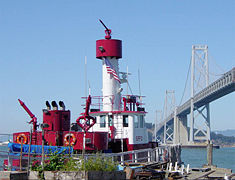
San Francisco Fire Department Auxiliary Water Supply System
Encyclopedia
The Auxiliary Water Supply System (AWSS, though often referred to on manhole cover
s and hydrants as HPFS) is a high pressure water supply network
built for the city of San Francisco in response to the failure of the existing emergency water system during the 1906 earthquake
. It was originally proposed by Dennis T. Sullivan in 1903 with construction beginning in 1909 and finishing in 1913. The system is made up of a collection of water reservoirs, pump stations, cisterns, suction connections and fireboats. While the system can use both fresh or salt water, it is preferential to not use salt water, as it commonly causes galvanic corrosion in fire equipment.
The large, white oversized hydrants that are supplied by the AWSS/HPFS are visible throughout the city, with painted tops that are color coded as to zone:
hilltop. It is made up of a 10.5-million-gallon storage reservoir
made out of 6 inches (152.4 mm) reinforced-concrete slabs. Fresh water is delivered from the city's domestic water system by two 750 gallons (2,839.1 l) centrifugal pumps. For safety, the reservoir is broken up into two tanks, and each tank can be emptied separately so that in case of a pipe breakage only half of the reservoir is lost. The tank is set at 758 feet (231 m).
Both stations are capable of pumping 10000 gallons (37,854.1 l) per minute of salt water at a pressure of 300 psi with on-site generators.

Manhole cover
A manhole cover is a removable plate forming the lid over the opening of a manhole, to prevent anyone from falling in and to keep unauthorized persons out....
s and hydrants as HPFS) is a high pressure water supply network
Water supply network
A water supply system or water supply network is a system of engineered hydrologic and hydraulic components which provide water supply. A water supply system typically includes:# A drainage basin ;...
built for the city of San Francisco in response to the failure of the existing emergency water system during the 1906 earthquake
1906 San Francisco earthquake
The San Francisco earthquake of 1906 was a major earthquake that struck San Francisco, California, and the coast of Northern California at 5:12 a.m. on Wednesday, April 18, 1906. The most widely accepted estimate for the magnitude of the earthquake is a moment magnitude of 7.9; however, other...
. It was originally proposed by Dennis T. Sullivan in 1903 with construction beginning in 1909 and finishing in 1913. The system is made up of a collection of water reservoirs, pump stations, cisterns, suction connections and fireboats. While the system can use both fresh or salt water, it is preferential to not use salt water, as it commonly causes galvanic corrosion in fire equipment.
The large, white oversized hydrants that are supplied by the AWSS/HPFS are visible throughout the city, with painted tops that are color coded as to zone:
- Black topped hydrants are in the West of Twin Peaks zone, and are fed by the Twin Peaks Reservoir.
- Red topped hydrants are in the upper zone, and fed by the Ashbury Street tank.
- Blue topped hydrants are in the lower zone, fed by the Jones Street tank.
Twin Peaks Reservoir
The Twin Peaks Reservoir acts as the backbone of the AWSS system and is located in San Francisco's Twin PeaksTwin Peaks, San Francisco, California
The Twin Peaks are two hills with an elevation of about near the geographic center of San Francisco, California. Except for Mount Davidson, they are the highest points in the city.-Location and climate:...
hilltop. It is made up of a 10.5-million-gallon storage reservoir
Reservoir
A reservoir , artificial lake or dam is used to store water.Reservoirs may be created in river valleys by the construction of a dam or may be built by excavation in the ground or by conventional construction techniques such as brickwork or cast concrete.The term reservoir may also be used to...
made out of 6 inches (152.4 mm) reinforced-concrete slabs. Fresh water is delivered from the city's domestic water system by two 750 gallons (2,839.1 l) centrifugal pumps. For safety, the reservoir is broken up into two tanks, and each tank can be emptied separately so that in case of a pipe breakage only half of the reservoir is lost. The tank is set at 758 feet (231 m).
Ashbury tank
The Ashbury tank has a direct connection to the Twin Peaks reservoir and has a total capacity of 500000 gallons (1,892,706 l). The tank is set at 494 feet (150.6 m) and, when combined with the Jones street tank, can provide hydrants with 214-psi pressures. It is located in the city's Ashbury Heights neighborhood.Jones street tank
The Jones street tank has a direct connection to the Ashbury tank and has a total capacity of 750000 gallons (2,839,059 l). The tank is set at 369 feet (112.5 m), providing hydrants with 160-psi pressures. It is located in the city's Nob Hill neighborhood.Pump stations
There are two emergency pumping stations present within the AWSS.- Pump Station No. 1 - 2nd at Townsend St.
- Pump Station No. 2 - Van Ness Blvd at McDowell Ave.
Both stations are capable of pumping 10000 gallons (37,854.1 l) per minute of salt water at a pressure of 300 psi with on-site generators.
Fireboats
To supplement any outright failure of the pumping stations or reservoirs, two fireboats can be utilized to deliver salt water into the system.- Phoenix - 9600 gallons (36,340 l) per minute at 150 psi
- Guardian - 24000 gallons (90,849.9 l) per minute at 150 psi (largest pumping capacity of any fireboat in the world)


